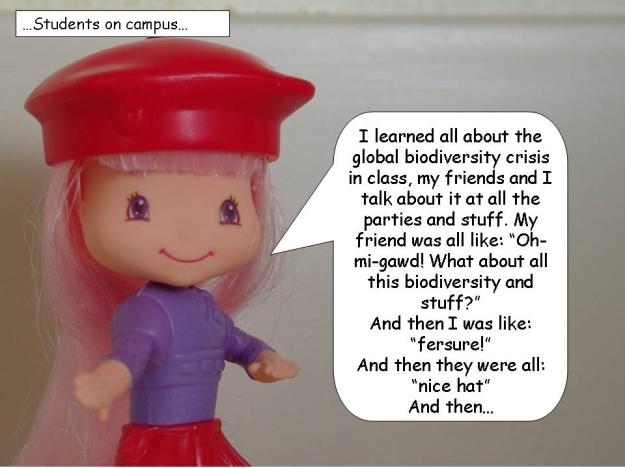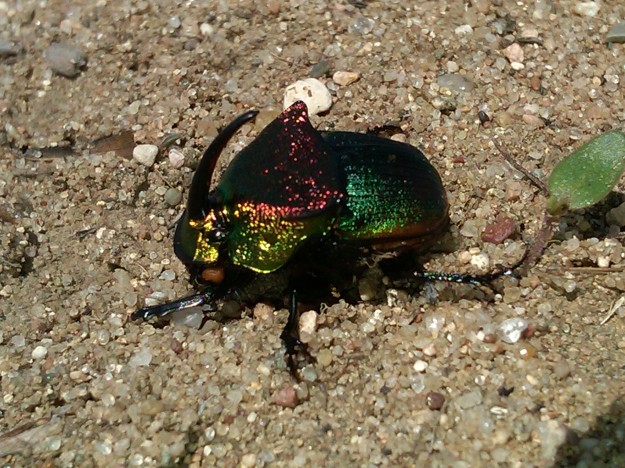Kelly and I were on yet another cross-country automobile adventure. While in Kansas we decided that a fueling up and pee stop before we hit Kansas City was a good idea. When we walked into the building after pumping fuel we saw Halyomorpha halys was sitting on the wall of EZ Go #70! Very excited, we photographed the stink bug and collected it. We called our friend Brian McCornack, who being an entomologist in Kansas, was able to rapidly confirm that this was the FIRST STATE RECORD for Kansas! Well, celebrating a new non-native pest doesn’t seem like a good idea, but being able to pinpoint when a pest enters a new area can be valuable information and now other entomologists know to look out for it. The reason I am telling you about it now is the latest Journal of the Kansas Entomological Society has a short communication that we wrote about this occurrence. It should be in your mailbox any day now, or give me your email and i’ll send you a pdf.
Monthly Archives: October 2012
Biodiversity Crisis
BAMONA
BAMONA stands for butterflies and moths of North America, a citizen-science project, for which I serve as the Idaho state coordinator, and share duties for Wyoming. Recently, a sighting came to me for verification and I was staring at a beautiful photograph of Aglais urticae on my computer screen. WOWIE ZOWIE! Stop the presses! This species is known from North America, but not the Pacific Northwest. AND IT IS SUPER RARE!
I verified the photograph, and included a note to the person who submitted it about how significant it was. The photo showed the species on a flower of Helianthus annuus, a nice iconic North American species. As soon as I thought that I flashed back to the fields of sunflowers the Tour de France rolls through, and how can I be certain of physical location.
Well, they had been to Ireland, maybe they were mistaken about the location and withdrew their sighting. So in the end it all worked out, but for a while I was pretty excited!
The magical giant squid
In my Anatomy and Physiology class we used the giant axon of the squid for a really cool lab on action potentials. Well, today we did the lab again, but I got to be the squid! I am the squid! coo-coo c’joob!
I am the squid! coo-coo c’joob!
Well it was really fun twitching and jerking all over the place. Hooray for the sodium-ion pump!

The smallest butterfly
Kelly and I were hiking around at the Hansen Bridge Cooperative Management Area and I saw an extremely large Brephidium exile on flowers of Ericamera nauseosa. It isn’t the best photo I have taken of this species, but it is cool just because of the enormous size of this normally tiny insect.
I have watched this butterfly laying eggs on Salsola tragus and Halogeton glomeratus, but I have only found caterpillars on Atriplex canescens. All three plants are in the Chenopodiaceae, but only Atriplex canescens is native. If Brephidium exilis is able to successfully breed on the non-native plants, then it can potentially breed in many very weedy habitats beyond the ancestral ones. Brephidium exilis is guarded by ants as a caterpillar, so maybe only weedy areas with the correct ants.
Scarabs!
Today’s big excitement is the latest edition of SCARABS. This issue has a spiffy article about making dung beetle traps by yours truly. If you have ever wanted to sample dung beetles, now is your big chance! These traps are identical to the traps used by Joey Abrego who undertook an important dung beetle trapping question as his FFA project: POOPSICLES or FRESH. I highly recommend you spend some time trapping.
Because the links have died over time, here is a link to the article if you want to make some traps.
Johnny Asilid Danger Force Nine
Still recovering from surgery, I found this old comic that My daughter, Jennifer Wren, and I put together after some field time at Niagara Springs WMA back in 2004. Jenny and I did the story and cool name. Jenny did all the art work. The comic originally appeared in the Idaho Entomology Group‘s newsletter
Asilids are hunting flies and super-cool, therefore the comic is of a more serious nature. If you have the opportunity, take some time out to watch them – they are ultra cool.

native versus non-native
Kelly and I were asked to speak at the Treasure Valley Bee Keepers Club recently. The CSR blog has some of the nuts and bolts of the talk. It is of interest that a non-native, agricultural animal, the honey bee, is creating an interest in native plants. Native plants can provide excellent food to keep honey bees healthy and producing honey. The Treasure Valley Bee Keepers Club recognizes this. What a great win-win urban farming and native plants!
Triops longicaudatus, the Tadpole shrimp
Hey all, I have been down due to surgery but thought a quick post about the manuscript Kelly and I just had published in the Journal of Integrated Pest Management was in order.This was a fun project from the get go. Consider growing some shrimp with your kiddos. They are really that cool.
In addition to getting to play with a neat organism, we also got to find where in Missouri shrimp were located. This is important knowledge for rice farmers and provides a starting point from which range enlargement can be judged.
Read the paper and maybe you can have your shrimp fun this winter.













